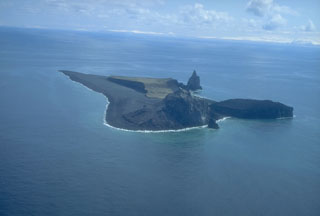Report on Bogoslof (United States) — 21 June-27 June 2017
Smithsonian Institution / US Geological Survey
Weekly Volcanic Activity Report, 21 June-27 June 2017
Managing Editor: Sally Sennert.
Please cite this report as:
Global Volcanism Program, 2017. Report on Bogoslof (United States) (Sennert, S, ed.). Weekly Volcanic Activity Report, 21 June-27 June 2017. Smithsonian Institution and US Geological Survey.
Bogoslof
United States
53.93°N, 168.03°W; summit elev. 150 m
All times are local (unless otherwise noted)
AVO reported that slightly elevated surface temperatures at Bogoslof were identified in satellite images on 23 June, and steam emissions were occasionally observed the previous week. Beginning at 1649 on 23 June a significant explosive event was detected in seismic and infrasound data that lasted about 10 minutes. It produced an ash plume that rose as high as 11 km (36,000 ft) a.s.l. and drifted 400-490 km E. The event prompted AVO to raise the Aviation Color Code (ACC) to Red and the Volcano Alert Level (VAL) to Warning. Four additional explosions were detected, during 1918-1924, 2013-2021, 2104-2112, and 2152-2155, though any resulting ash plumes were not detected above the cloud deck at 8.5-9.1 km (28,000-30,000 ft) a.s.l. On 25 June the ACC was lowered to Orange and the VAL was lowered to Watch. At 1645 on 26 June an eruption which lasted about 14 minutes produced an ash plume that rose 7.6 km (25,000 ft) a.s.l. Seismic and lighting data indicated that a significant explosion began at 0317 on 27 June, prompting AVO to raise the ACC to Red and the VAL to Warning. The event lasted 14 minutes, and produced an ash plume that rose 9.1 km (30,000 ft) a.s.l. and drifted NW. The ACC was lowered to Orange and the VAL was lowered to Watch later that day.
Geological Summary. Bogoslof is the emergent summit of a submarine volcano that lies 40 km N of the main Aleutian arc. It rises 1,500 m above the Bering Sea floor. Repeated construction and destruction of lava domes at different locations during historical time has greatly modified the appearance of this "Jack-in-the-Box" volcano and has introduced a confusing nomenclature applied during frequent visits by exploring expeditions. The present triangular-shaped, 0.75 x 2 km island consists of remnants of lava domes emplaced from 1796 to 1992. Castle Rock (Old Bogoslof) is a steep-sided pinnacle that is a remnant of a spine from the 1796 eruption. The small Fire Island (New Bogoslof), about 600 m NW of Bogoslof Island, is a remnant of a lava dome formed in 1883.
Source: US Geological Survey Alaska Volcano Observatory (AVO)

